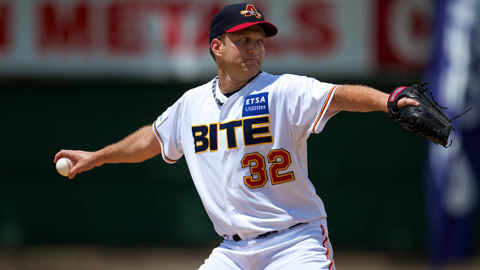Pat Ahearne: Former Tigers RHP
1. Could you tell us your story on dropping down?
There isn't such a story to tell of the development of my arm angle other than it came about naturally. As I got more coaching and learned more about proper arm slot and factors that affect it, my angle probably shifted and moved around. It has primarily hung out at low 3/4 most of the time. Funny enough, it never felt like a low arm slot when I throw.
2. What are some of the advantages you had from your arm angle?
The biggest advantage is the pitch movement that an arm slot like this creates.
There are matchup advantages going righty vs. righty from this arm slot.
On the flip side, it made things more challenging to throw a breaking ball with more downward movement. That's why a sinker/curve pitcher is more rare than a sinker/slider guy.
3. If you didn't drop down, do you think you would have had the same success?
There wasn't a decision for me to go from one arm slot to another. This has always been my way so there isn't really a way to compare before/after.
4. What would you tell someone debating on changing their arm angle?
For someone debating a change, experiment with it. Try different slots in the bullpen. Ask your catcher which works better. Figure out which is more consistent and more effective. Additionally, a shift doesn't have to be all or nothing. You could use a low arm slot from time to time as "another pitch" to show the hitter a different look.
5. Are there any mechanical tips that you'd give to someone throwing sidearm/submarine?
Mechanically, just remember that any healthy arm slot is created by a 90 degree angle created from elbow to torso. A sidearm move or lower arm angle or even an overhand arm slot is mostly created by bending at the waist to go low or tilting back to get a higher release point. So mechanically just check angle from elbow to torso going into release.
6. What pitches did you throw?
I threw a sinker as my fastball, my second pitch was my change up. My breaking ball I called a curve and always went for more downward break than a lateral one. At times in MY career I threw cutters and sliders, but not on a consistent basis as my other pitches were successful enough to go with a 3 pitch arsenal.
7. How did you pitch to lefties/righties?
Whoever was at the plate was going to get a steady diet of sinkers. Until a player could prove they could do something with it, thats what they got. I would also gauge and upset a hitters timing and mix in a change up (which sank more than my fastball).
Vs righties, I'd run the sinker inside and pay attention to the hitter. If he got a good swing on it, I knew that was what he is looking for so I'd go away for the out with a fastball away or breaking ball because a hitter keying on a sinker running down and in means the outer half is wide open.
For lefties it was sinkers away with change ups. If a lefty started to go the other way with a fastball, I would pitch inside. With my breaking ball to lefties I'd usually try to put it in the ground and get a swing and miss.
8. Lastly what was your favorite part about pitching from down there?
The best part of this is to have a sinker as a result of the arm angle which is a consistent weapon. It becomes something, for most hitters, even if they know it's coming still can't make solid contact other than a ground ball.
I have gotten many swing and miss from the sinker when it's on and many more ground outs on average.
Having a pitch that always has a good chance to get outs even if everybody knows it's coming means you are a power pitcher. Doesn't matter what the radar gun says.





